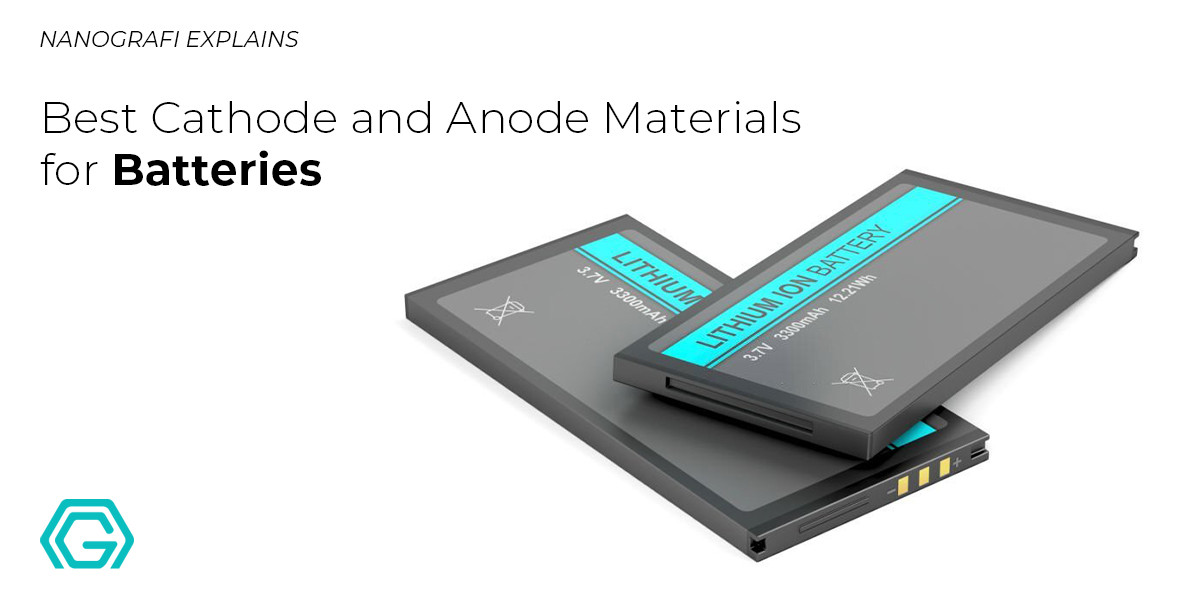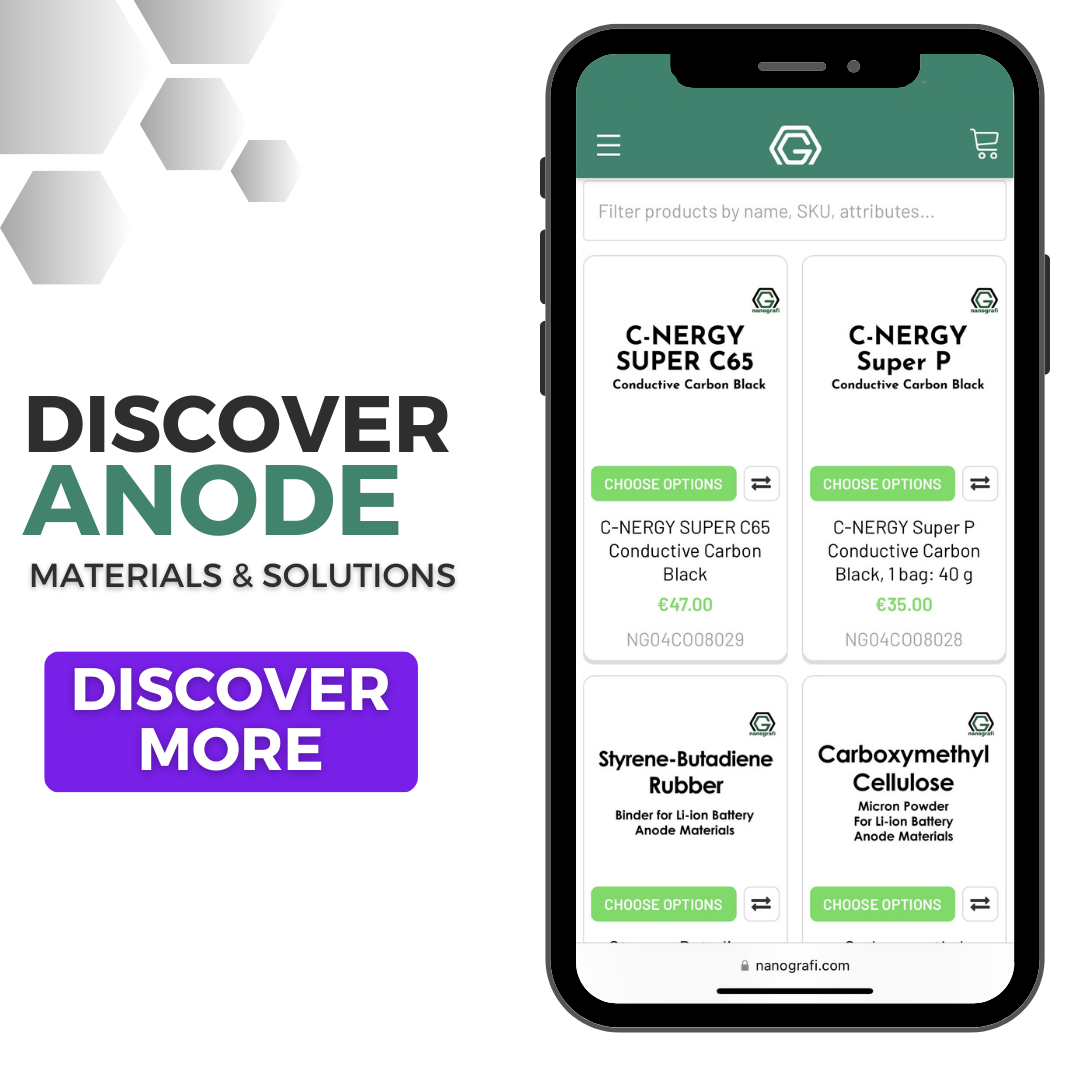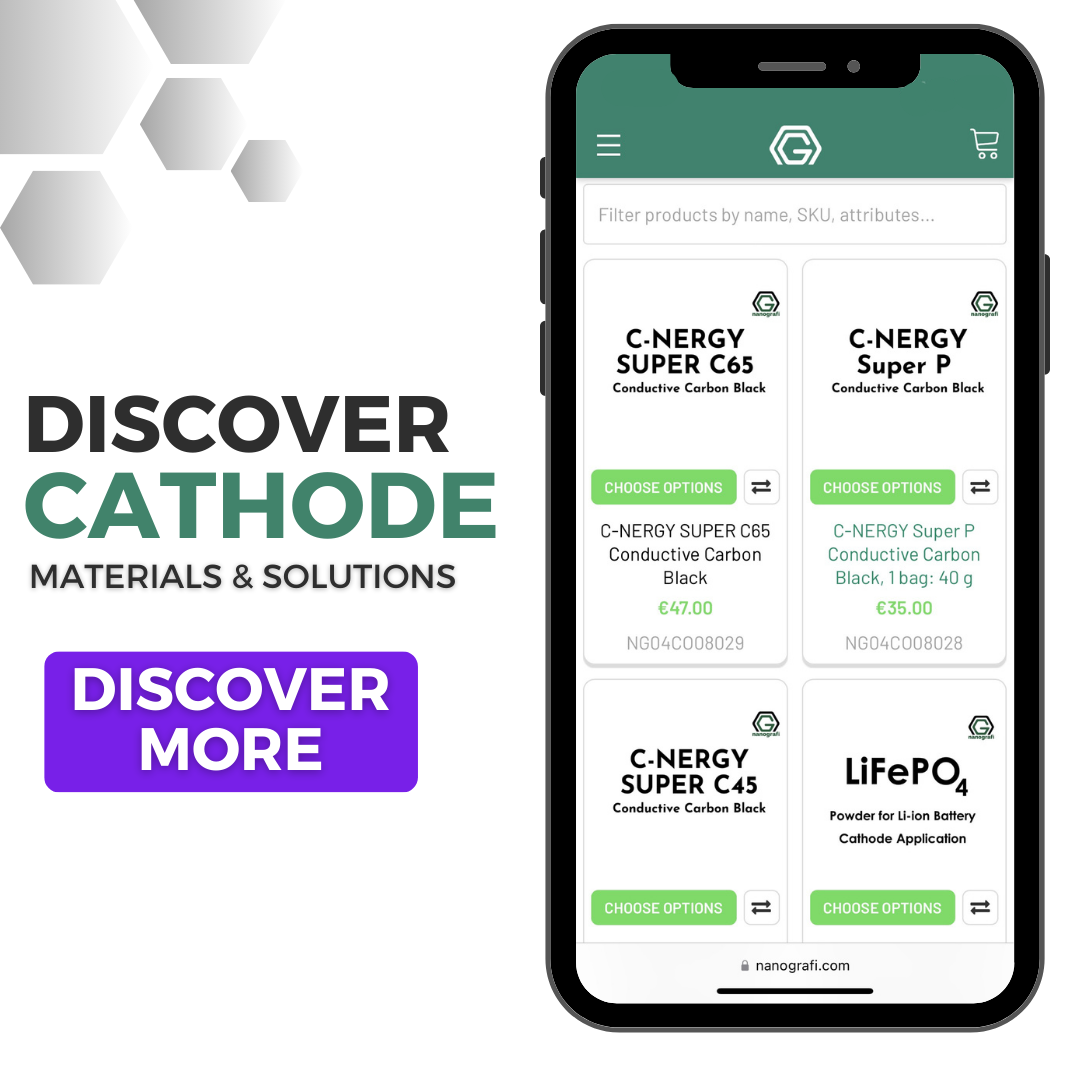Best Cathode and Anode Materials for Batteries
Cathode and Anode materials are a part of every battery solutions because this is the main source of how the working of a battery is enhanced or properly stimulated.
Within an electrochemical cell, the anode is designated as the negative electrode, where oxidation takes place, in contrast to the cathode, which functions as the positive electrode for reduction. The critical roles these components play in electron flow are underscored, as they are essential for maintaining electrode and chemical charge balance.
Introduction
Cathode is responsible for the positive charge and the anode is responsible for the negative charge and their division is carried out by an electrolytic solution most commonly known as an electrolyte.
In various technologies, for instance, Hybrid Electric Vehicles (HEV) uses both, lithium-ion batteries and electric motor engines for increasing fuel efficiency. Essentially, many electrochemical cells joined in parallel or series are known as a battery and they provide capacity and voltage.
A negative (anode) and positive (cathode) electrode are in each cell, separated by an electrolytic solution, known as an electrolyte. The transfer of the ion between the electrodes is allowed by the dissociated salt. When an external source is connected with these electrodes, as a result of chemical reaction, electrons are released and therefore for tapping the current.
Anode and Cathode Materials
In the realm of electrochemistry, anode and cathode materials play pivotal roles in the functioning of various devices, such as batteries and electrolytic cells.
Anode, characterized as the negative electrode in an electrolytic cell, is where the oxidation reaction occurs. This definition is crucial for understanding the directional flow of electrons and ions within the cell.
In contrast, Cathode, known as the positive electrode, is the site for reduction reactions. This distinction between anode and cathode is fundamental, as it dictates the flow of electrical current through an external circuit.
In an electrolytic cell, the anode's role as the negative pole is not arbitrary but is defined by its behavior in the oxidation process, where it loses electrons. This process is integral to the cell's ability to drive non-spontaneous chemical reactions through the application of an external voltage.
The materials chosen for these electrodes are critical, as they directly influence the efficiency, capacity, and longevity of the cell. The selection of anode and cathode materials is a sophisticated area of research, aiming to optimize the electrochemical performance of cells for a wide array of applications, from energy storage in batteries to the separation of compounds in industrial processes.
Anode Materials
Lithium alloyed metals and carbon (graphite)-based materials are the two most used anode materials today. Oxide spinel Li4Ti5o12 is a commercialized lithium alloyed metal. For avoiding the issues in safety and cycling, like the formation of dendrite on anodes of lithium, the usage of minimal potential intercalation electrode is advisable.
The inserted lithium is protected by the found element in the graphite intercalation alloy, therefore rendering it less reactive towards the electrolytes, lessening the lithium amount in the lithiated material.
It has advantages as well as disadvantages. The disadvantage manifests in the form of performance loss due to the lessening in the voltage of the cell therefore reducing the power and energy density further. The advantage is that any dangers regarding the electrochemical reactions' flammability are accounted for.
Novel Graphite and Non-Graphitic Anodes
Kish graphite-like graphite carbons and altered natural graphite are used to make various advances in the field. Due to natural graphite's oxidation in air, on the modified graphite, the electrochemical properties are more enhanced according to the recent studies. At 3000 C and more temperatures, heat treatment is required for the artificial development of graphitic anodes, which demands higher energy and may result in the formation of gaseous materials. 372 mAh/g is the Lithium intercalation capacities theoretical value of Kish graphite.
Also, Kish graphite can be produced at 1500 C temperature. The graphene domains are possessed by the Non-graphitic carbons and not the graphene’s structural order. These are the disordered carbons. The natural graphene's irreversible capacity doesn't compare with their irreversible capacity, still, in solid electrolyte interface disruption, these materials are less vulnerable, making them a perfect candidate for being paired with the lithium-manganese oxide where the metal’s dissolution is competitive.
Carbonaceous (Carbon-Based) Anodes
As told in the start, graphite is a primary carbon material to be used as an anode. They have packet sheets in rhombohedral (ABC) or hexagonal (AB) arrangements. Staging occurs when the graphene sheets reorganize themselves in AA arrangement on each other’s top on the insertion of Li-ion.
The pros are, its remarkable electrochemical characteristics, accessibility, and minimal cost. In Lithium-ion batteries, the key anode material is carbon. Although poor lithium intercalation capacity is exhibited by graphite carbon than Li-ion alloys. In commercial Lithium-ion cells and portable devices, mainly, as an anode material, the graphitic carbons are utilized.
Thanks to Lithium's optimal cycling ability, and higher acceptance, claiming performance is exhibited by the crystalline carbon. It has the flexibility to the temperature control due to its organic structure. Enhancements are being constantly shown in discharge capacity and charge-discharge efficiency of carbonaceous anodes through modifications in surface and structure. Hitachi designed artificial graphite by altering the structures of particles and pores to make new developments.
Cathode Materials
The active and major source of all of the Lithium ions in the Lithium-ion battery chemistry is the cathode material. Rechargeable Lithium-ion batteries or Lithium metal determines the positive electrode material’s preference. The lithium metal functions as a negative electrode when lithium metal is utilized in the rechargeable lithium batteries, therefore, there is no need for a positive electrode to be lithiated.
In the Lithium ion's case, the positive terminal must act as the Lithium ion's source due to the carbon electrode which acts as a negative, not having lithium, thus, for the cell assembly, an intercalation compound is needed. Lithium layered metal oxides, LiFePO4, Li-Mn-O, and LiCoO2 are the most common cathode materials.
Lithium Manganese Spinels
Despite being the oldest compounds, dating back to ages, Li-Mn-O is still being utilized in a broad range. It was used as a depolarizer first. It has remarkable electrochemical characteristics, it is cheap and is accessible easily. Lithium manganese (Li-Mn) is the battery material that is mostly used in a wide range than the toxic and expensive lithium cobalt-based (LiCo-O), and lithium-nickel-based (Li-Ni-O) which is difficult to be made.
For lithium and small helium ions' intercalation, various forms of it make it ideal. With its spinel, the lambda form (Mn2O4) allows for the Lithium-ion’s intercalation. Environmental impacts, minimal health, great rate capability, and high thermal threshold are some of the Lithium-manganese spinels’ benefits.
In this compound, 10-6 -10-10 sq. cm/s is the diffusion rate for a lithium-ion. On frequent cycling, complications arise in the reduced capacity because of the electrochemically active Mn3+ ion’ instability above 55o C temperatures. Enhancements can be done in such cases by doping the selected metal ions (Mg, Ni, Mg, Fe, Cr, Co, Al, etc.) and coating the acid-resistant materials on the LiMn2O4 for obtaining various structural stability.
Lithium Metal Oxides
For lithium-ion batteries, the most in-depth studied material for the cathode is cobalt oxides and lithiated nickel. The high stability of structure characterizes both of them. They are expensive and difficult to make as the resources are limited.
In the development of these layered compounds’ solid solutions, there is a resolution. The solid solution compounds that are most common are Li1.2Cr0.4Mn0.4O2 and Li Ni0.5Mn0.5O2.
In research, it is seen that the combination of low strain in the activated state and low-valent transition metal ions is the key to high rate capability cathodes. For the applications which need fast discharging and charging, the perfect material is layered metal oxides. When subjected to above 300 C temperature, these materials do well on capacity.
Lithium Iron Phosphate (LiFePO4)
LiFePO4 is the name of their compound. They are not toxic. As compared to the Lithium-cobalt based cathode, major safety benefits are provided by them, making them favorable and beneficial for applications of higher level.
Differences Between Anode and Cathode
In the emerging world of battery technology, the distinction between anode and cathode materials is paramount. While both serve as essential components within batteries, understanding their differences is crucial for unlocking the full potential of energy storage systems and tech-driven lives.
Electrochemical Functionality
- Anode: The anode acts as the negative electrode in a battery, where oxidation reactions occur during discharge. It serves as the source of electrons, releasing them into the external circuit.
- Cathode: Conversely, the cathode operates as the positive electrode, facilitating reduction reactions. It accepts electrons from the external circuit during discharge.
Chemical Composition
- Anode: Anode materials typically include carbon-based compounds, lithium alloys, or other intercalation materials capable of accommodating lithium ions during charging.
- Cathode: Cathode materials vary widely and can include transition metal oxides, phosphates, or other compounds capable of storing lithium ions during charging.
Voltage Potential
- Anode: Anode materials typically have a lower voltage potential compared to cathode materials, reflecting their role in donating electrons during discharge.
- Cathode: Cathode materials generally exhibit higher voltage potentials, as they are involved in the acceptance of electrons during discharge.
Structural Stability
- Anode: Anode materials must maintain structural stability during repeated lithiation and delithiation cycles, which can pose challenges such as volume expansion and electrode degradation.
- Cathode: Cathode materials also face stability issues, but advancements in material design aim to mitigate concerns such as structural degradation and capacity fade.
Energy Density and Capacity
- Anode: Anode materials typically contribute less to the overall energy density of a battery compared to cathode materials but play a crucial role in determining specific energy and power characteristics.
- Cathode: Cathode materials often have a higher energy density, making them a critical factor in overall battery performance and capacity.
Understanding these differences is essential for optimizing battery design and performance across a wide range of applications, from consumer electronics to electric vehicles and grid-scale energy storage.
The Role of Anode and Cathode Materials
The efficiency, safety, and capacity of lithium-ion batteries are intricately intertwined with the selection of materials for the cathode (positive electrode) and anode (negative electrode). These materials are not mere passive elements but active contributors to battery performance optimizations.
The choice of anode and cathode materials is crucial for tailoring battery characteristics to meet the diverse demands of specific applications. Whether it's maximizing energy density for electric vehicles or ensuring long-term reliability for grid-scale energy storage, the selection process is a critical optimization step.
Energy Density
Anode and cathode materials significantly influence battery energy density, determining how much energy can be stored per unit volume or weight. High-capacity materials like lithium cobalt oxide (LiCoO2) or nickel manganese cobalt oxide (NMC) can enhance energy density, crucial for compact and lightweight applications like smartphones or electric vehicles.
Safety
Materials impact battery safety, with some prone to dendrite formation or thermal runaway. Stable anode materials like graphite and cathode materials like lithium iron phosphate (LiFePO4) are preferred for their safety characteristics, reducing risks of short circuits or overheating.
Cycle Life
Anode and cathode materials affect battery cycle life, with stable materials experiencing less degradation over repeated charging and discharging cycles. Graphite anodes and certain lithium transition metal oxides for cathodes contribute to improved cycle life and long-term reliability.
Rate Capability
Materials with high conductivity and fast lithium-ion diffusion kinetics enable rapid charge and discharge processes, vital for high-power applications like electric vehicles or grid stabilization. Anode and cathode materials play crucial roles in enabling efficient power delivery at high discharge rates.
In essence, the meticulous selection and optimization of anode and cathode materials are essential for developing advanced battery technologies. This ensures batteries meet specific application requirements while maintaining optimal performance, safety, and reliability.
Conclusion
Li-ion batteries are highly capable of exhibiting flawless features and that is only possible when the right amount of charge is able to flow through the battery. Cathode and Anode materials make it possible to do so that’s why it is impossible for a battery to work without them as the basic necessity of a battery is cathode and anode materials.
To follow the latest articles and research, you can visit Blografi.
References
Dunn, J. B., Gaines, L., Barnes, M., Wang, M., & Sullivan, J. (2012). Material and energy flows in the materials production, assembly, and end-of-life stages of the automotive lithium-ion battery life cycle. https://doi.org/10.2172/1044525
Mekonnen, Y., Sundararajan, A., & Sarwat, A. I. (2016). A review of cathode and anode materials for lithium-ion batteries. Conference Proceedings - IEEE SOUTHEASTCON, 2016-July. https://doi.org/10.1109/SECON.2016.7506639
Recent Posts
-
Nanocomposites in Food Packaging
The utilization of nanocomposites in food packaging represents a significant advancement in the fiel …19th Apr 2024 -
What is the Difference Between 7075 and 6061 Aluminum Alloy?
When comparing 7075 aluminum alloy to 6061 aluminum alloy, it's essential to understand their disti …5th Apr 2024 -
Iron-Air Batteries: The Ultimate Guide
Iron-air batteries represent a significant breakthrough in energy storage technology, offering a sus …29th Mar 2024






